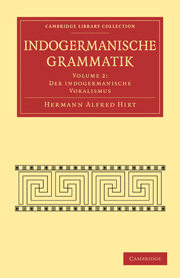Book contents
- Frontmatter
- Vorwort
- Contents
- Einleitung
- Erster Teil. Der Ablaut innerhalb der Silbe
- I Kapitel. Abstufung ei: i usw
- II Kapitel. Mannigfaltigkeit des idg. Vokalismus. Die Vokale e, a, o
- III Kapitel. Die langen Vokale
- IV Kapitel. Die Dehnstufe (D)
- V Kapitel. Die Langdiphthonge
- VI Kapitel. Die Reduktionsstufe (R)
- Zweiter Teil. Der Ablaut mehrerer Silben
- Dritter Teil. Ergänzende Fragen
- Wörterverzeichnis
- Umschreibung
- Abkürzungen
- Berichtigungen
IV - Kapitel. Die Dehnstufe (D)
Published online by Cambridge University Press: 05 February 2015
- Frontmatter
- Vorwort
- Contents
- Einleitung
- Erster Teil. Der Ablaut innerhalb der Silbe
- I Kapitel. Abstufung ei: i usw
- II Kapitel. Mannigfaltigkeit des idg. Vokalismus. Die Vokale e, a, o
- III Kapitel. Die langen Vokale
- IV Kapitel. Die Dehnstufe (D)
- V Kapitel. Die Langdiphthonge
- VI Kapitel. Die Reduktionsstufe (R)
- Zweiter Teil. Der Ablaut mehrerer Silben
- Dritter Teil. Ergänzende Fragen
- Wörterverzeichnis
- Umschreibung
- Abkürzungen
- Berichtigungen
Summary
65. Die dehnstufigen Längen. Neben den eben besprochenen ē, ā, ō, die mit ǝ ablauten, stehen andere, die zweifellos zu den kurzen Vokalen in Beziehung stehen. Das zeigt am besten das Verhältnis gr. πατήρ: Akk. πατέρα, das im Indischen durch pita, Akk. pitáram widergespiegelt wird. Ihr Hauptkennzeichen ist, daß die Kürzen hier im wesentlichen an betonter Stelle auftreten, und daß im Indischen a, im Lateinischen e erscheint.
Diese Längen haben die Foischung sehr beschäftigt. Wahrend sie Joh. Schmidt, KZ. 25, IB ff., für alt ansah und einen Ablaut ō: e: 0 (Null) ansetzte, hielt sie Brugmann, Curt. Stud. 9, 386 für verhältnismäßig jung, und er hat damit recht behalten. Er nahm an, daß die Dehnung auf den Nominativ beschränkt gewesen sei, und auch darin hat er etwas Richtiges geahnt.
Die richtige Einordnung der Längen in die kurzvokalischen Reihen hat zuerst Bartholomae gegeben, indem er BB. 17, 105 eine Dehnstufe (D.) annahm, d. h. es gibt lange Vokale, die durch irgendeine Dehnung aus den kurzen sekundär entetanden sind, und die daher mit den ursprüngliehen Längen nicht auf einer Linie stehen.
66. Umfang und Entstehung der Dehnstufe. Den Umfang und die Entstehung der Dehnstufe hat dann auf Grund der Anregungen von V. Michels Streitberg, IF. 3, 305 ff. im wesentlichen richtig dargestellt.)
- Type
- Chapter
- Information
- Indogermanische Grammatik , pp. 36 - 50Publisher: Cambridge University PressPrint publication year: 2009First published in: 1921



